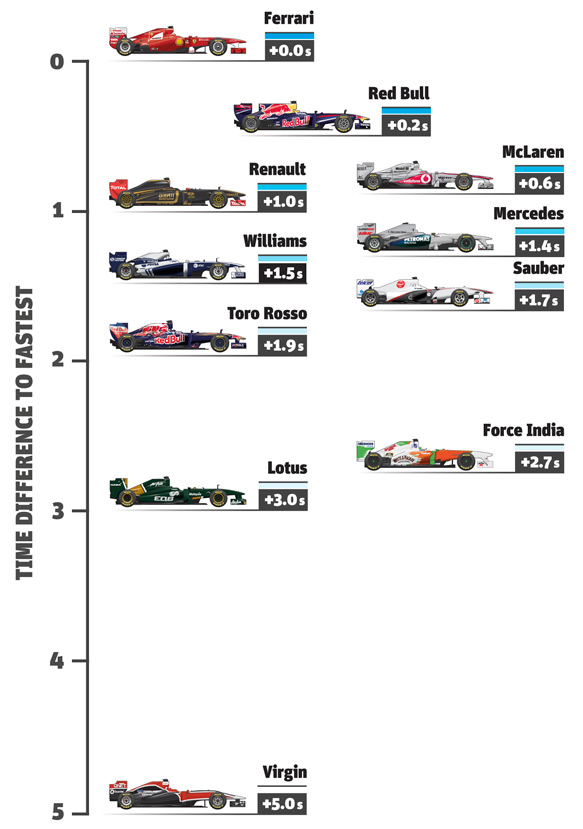Why Ferrari won the testing war
By Randeep Singh
Source: Autosport
Red Bull might be most people's favourite ahead of the weekend opener, but careful analysis of the final test in Barcelona shows that it may well be Ferrari that has the edge when the lights go out in Melbourne.
Detailed analysis of winter testing by AUTOSPORT indicates that it is Ferrari who will start the season as the pace-setting team. Examination of its performance - both on low-fuel runs and longer race simulations - clearly suggests that Ferrari has an edge over world champion Red Bull Racing ahead of the first race (see graphic below).
The headline times released at the end of the day can be very misleading since teams run vastly different programmes; most are experimenting with new parts, drivers can change between days, and of course there is always the temptation to bang in a headline-grabbing quick lap if a team is looking to assuage potential sponsors.
A more accurate estimation of relative pace can be achieved by taking long-run data and correcting it for factors such as tyre degradation and variations in grip level caused by the weather conditions.

For 2011 the new family of Pirelli tyre compounds and their sharper degradation characteristics makes any analysis somewhat coarse, especially where little data exists as to whether particular times were set on worn or fresh rubber. Nevertheless, factoring in the times over the entire week of the final test at Barcelona enables a degree of statistical 'smoothing'.
In terms of pace, the field – apart from HRT which did not run – is separated by five seconds, although the gaps between the leading teams are tighter.
Ferrari, Red Bull, McLaren and Renault are separated by a second, with Mercedes lagging a little although it improved demonstrably once development parts arrived.
Cars consume fuel at Barcelona at a rate of around 2.3kg every lap. Each kilogramme of fuel on board slows the car down by an average of 0.035s per lap. From this it is possible to calculate raw pace by subtracting the fuel penalty and factoring in tyre degradation and any benefits or penalties brought about by the track conditions.
What we see is that the times got slower on a lap by lap basis of around 0.2sec (accounting for fuel/tyres).
During the early part of the week Red Bull showed an advantage over the other teams in terms of fuel and tyre-adjusted pace, with McLaren over half a second behind and Ferrari a tenth or so further back. None of the midfield teams or backmarkers really surprised during this phase of the test, when most were concentrating on shorter runs.
Vitaly Petrov set impressive times in the Renault, which on an adjusted basis was not very far off the leaders - only a tenth or so away from the Red Bull – but fuel weights could have played a part in this.
On the fourth day there were several developments. Red Bull's long-run pace was not quite so impressive, although the RB7 was still quick on shorter runs. McLaren almost didn't feature, setting adjusted times slower than most of the midfield teams.
It's likely that both McLaren and Red Bull were running with considerable fuel.
The big story of the day was Alonso's blistering pace, set during one particular stint of a simulated race distance, where he posted his eight best (and the week's eight best) adjusted times, indicating a raw pace of around 1m19.2s. His nearest rival was actually Rubens Barrichello, who set the ninth to 12th best adjusted times during a stint where he managed a raw pace of 1m20.4s, followed closely by Schumacher on 1m21.0s.
Of course, it is impossible to achieve 100 per cent accuracy with any of these estimates given the variables, not only in terms of tyre degradation but also in terms of technical changes. McLaren, for instance, experimented with exhaust configurations during the test and have arrived at Melbourne with a substantially revised car.
Still, bearing in mind that teams would have run different amounts of fuel over the week, different set-ups and parts, and that the track was in better condition at different times, it is possible to estimate the adjusted pace over the week as a whole.
And that estimate suggests that far from being clearly in front, Red Bull is actually two tenths of a second behind Ferrari on adjusted pace – something that could provide a race-winning advantage this weekend.
.